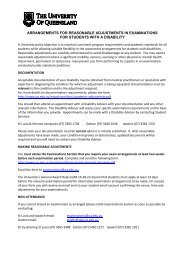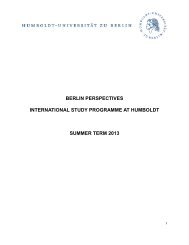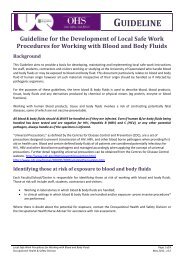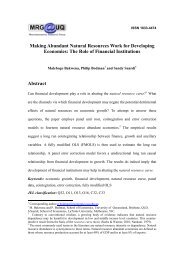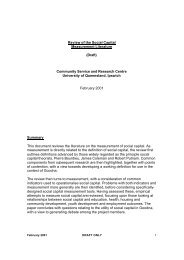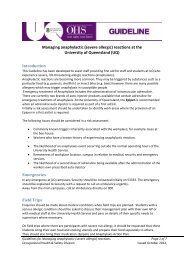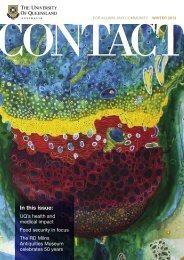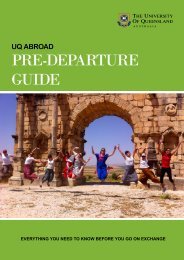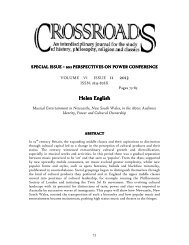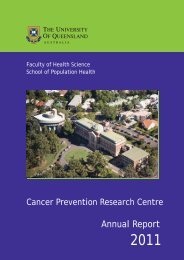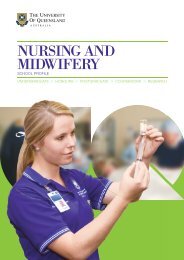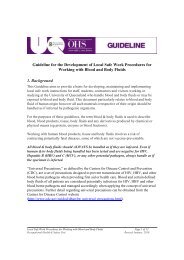Managing Traffic Incidents - University of Queensland
Managing Traffic Incidents - University of Queensland
Managing Traffic Incidents - University of Queensland
You also want an ePaper? Increase the reach of your titles
YUMPU automatically turns print PDFs into web optimized ePapers that Google loves.
that land uses are fixed, both in location and<br />
magnitude. However, it may be relevant to consider<br />
the relationship between 'land-use' and<br />
'transport' for three reasons (5):<br />
– Land-use activities and the interactions between<br />
them generate the demands for transport;<br />
– These activities and interactions are influenced<br />
by the availability <strong>of</strong> transport; and<br />
– The linkages between transport and activities<br />
may be important to the appraisal <strong>of</strong> transport<br />
strategies - especially when trying to<br />
consider whether the transport system is providing<br />
the kind <strong>of</strong> accessibilities that people<br />
and businesses require, rather than simply<br />
providing mobility.<br />
It may be feasible to explore these issues without<br />
adopting land-use models. Different land<br />
use inputs can be employed to explore the sensitivity<br />
<strong>of</strong> transport models to land-use, while<br />
the impacts on land-use <strong>of</strong> different transport<br />
strategies can be assessed, based on the outputs<br />
<strong>of</strong> transport models. However, where these relationships<br />
are complex the use <strong>of</strong> a formal<br />
modelling approach may be required.<br />
'Land-use/transport interaction models' represent<br />
the influences <strong>of</strong> transport upon different<br />
groups <strong>of</strong> economic agents (individuals and<br />
household, firms and other productive organisations,<br />
and national and local government) by<br />
modelling some or all <strong>of</strong> the markets (property,<br />
labour, and goods and services) through which<br />
they interact. As their name indicates, they<br />
model both the transport and land-use systems,<br />
though physical land-use is generally less important<br />
than the behaviours <strong>of</strong> residents and<br />
firms.<br />
The economic interactions between activities,<br />
such as flows <strong>of</strong> workers to workplaces or <strong>of</strong><br />
services to consumers, are obviously related to<br />
transport demands. Land-use/transport interaction<br />
models can be classified into the following<br />
two broad groups according to their treatment<br />
<strong>of</strong> these interactions:<br />
– Group 1 consists <strong>of</strong> modes where the economic<br />
interactions between activities are<br />
used in predicting where land-uses will lo-<br />
The emphasis UK placed Multi-Modal on the participation <strong>of</strong> stake-<br />
Transport models work Studies<br />
on the assumption<br />
holders and the community in the development<br />
<strong>of</strong> the studies.<br />
As the table below shows, there are a number<br />
<strong>of</strong> Consultation Models that have been<br />
adopted in transport planning.<br />
Participation is fundamentally different to<br />
consultation in that it allows participants to<br />
have a direct influence in the development and<br />
outcomes <strong>of</strong> the studies.<br />
It could be argued that studies would deliver<br />
the best results if the highest practical degree<br />
<strong>of</strong> participation were achieved throughout the<br />
study process from identification <strong>of</strong> transport<br />
objectives and possible options to be assessed.<br />
This would help ensure that all reasonable options<br />
were considered and would maximise the<br />
chances that the preferred transport strategy<br />
would succeed and be accepted given the potential<br />
level <strong>of</strong> ownership from stakeholders<br />
and the community.<br />
To achieve this requires a fully integrated<br />
and responsive approach from the study management<br />
and study consultants to the consultation/participation<br />
process. The outcomes <strong>of</strong> the<br />
study (including consultation/participation<br />
process) need to be disseminated at timely intervals<br />
throughout the study process. It is also<br />
important that as many local people and organisations<br />
as possible know about the studies<br />
and that the consultation/participation process<br />
encourages a healthy and lively debate as well<br />
as some excitement about the studies. This is<br />
best achieved if the teams undertaking the<br />
studies fully value the contributions that can<br />
be made from stakeholders and communities,<br />
and crucially that these groups can have a direct<br />
influence on the outcome <strong>of</strong> the studies.<br />
Transport Modelling/Assessment Tools<br />
Four groups <strong>of</strong> tools or procedures that have<br />
been used in the studies are:<br />
– Transport or a land-use/transport interaction<br />
models;<br />
– Environmental impact assessment procedures;<br />
– Cost/benefit analysis procedures; and<br />
– Geographic information systems.<br />
One <strong>of</strong> the main features <strong>of</strong> the studies is the<br />
use <strong>of</strong> strategic land use/transport models.<br />
Greater community/stakeholder involvement<br />
Non Participation Manipulation? Information Tokenism? Collaboration Empowerment<br />
12 DECEMBER 2001<br />
Decide – Announce<br />
– Defend<br />
Public Relations<br />
Marketing<br />
Public Information Consultation Participation Coproduction




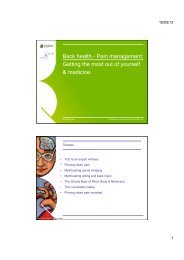
![Recycling [ PDF, 62KB ] - University of Queensland](https://img.yumpu.com/51805185/1/184x260/recycling-pdf-62kb-university-of-queensland.jpg?quality=85)
